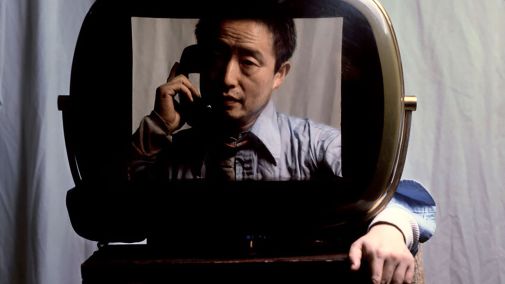Doc Corner: Steven Yeun Narrates 'Nam June Paik: Moon is the Oldest TV'
 Thursday, March 30, 2023 at 3:00PM
Thursday, March 30, 2023 at 3:00PM 
Let’s be honest. Artist bio-docs are a dime a dozen. Many artists have received the treatment, even though documentary is (almost as if entirely by the medium’s nature) a not particularly good artform of its own within which to interrogate the life of somebody like Nam June Paik. Despite video being so integral to his work, much of its impact inevitably comes from being able to see his work flicker in front of your face rather than on the TV screen. Screens within screens.
For that reason I suspect Nam June Paik: Moon is the Oldest TV would be really great to see theatrically. Where the kaleidoscopic colours and swirling digital artistry could be brought to life in as immersive a way as they probably possibly could beyond seeing them in the technological flesh.
Director Amanda Kim impresses in her first feature film, having already played the Sundance Film Festival. She gives this Korean pioneer a worthy portrait that details the how and the why of his legacy within the art world as told through his story as an immigrant and the eclectic nature of his art that included such striking uses of technology. On this, though, Kim is wise to spotlight Paik as somebody who was ahead of even those who were ahead of their curve, exploring through his work an array of ideas and concepts (including, most strikingly, the very internet that we are all on right now) that put him at the forefront of the art scene even if people didn’t recognise it until sometime later.
Unlike some of the stronger artist bio-docs of recent years (Wojnarowicz being a good example), Moon is the Oldest TV doesn’t really try to recreate the allure of its subjects work within the form of the narrative. It’d be hard to do that with Paik’s boundary-pushing avant garde style, but Kim along with editor Taryn Gould make smart work of how they choose to integrate Paik’s work where possible within a raft of archival footage and interviews with fellow artists, curators and critics. The attempt is one of video-collage, and it largely works. But the wild sensibility—that confronting power that made people feel as if they were seeing something truly new and not even of this world; something futuristic and yet which hits deep in the stomach—is lacking. Compared to his legacy as an innovator and a man who turned science fiction into art, Moon is the Oldest TV is modest.
Steven Yeun is on board as an executive producer and also as a narrator, reading excerpts from Paik’s writings. A nice touch that connects one generation of Asian artists to another. Kim’s focus on Paik’s Korean heritage is actually very important to the overall effect that Moon offers the viewer. Where another filmmaker may have not given it the same level of importance within his story, distilling it to his time in Japanese-occupied Korea, here the director makes an astute connection between the culture he was born into and how it affected and altered his perception of art upon his emigration to places like Berlin and New York City. And how these cities perceived him because of his culture. This includes his background as being from a wealthy, albeit “corrupt” (his words), family.

Some may have wished for a deeper exploration of what his work actually means. I’m not entirely sure Kim’s film needed that, as if reciting us the little plaques that adorn museum walls next to his pieces in retrospectives and collections. Hopefully the evidence of his talents that are on display in this film are enough to entice further reading. This is not an exhaustive history lesson. To be perfectly honest, Paik probably isn’t the best subject given his awkwardness on screen as seen in interviews from before his death in 2006. But Moon is the Oldest TV (stay through the credits for an amusing explanation of the title courtesy of Marina Abramović) is engaging and charming and makes a strong case of Nam June Paik as one of the more vital yet under-discussed artists of the 20th century.
And just because you can’t go too far through this world without him, Jonas Mekas does indeed show up in archival footage. Because of course he does.
Release: Currently screening at New York's Film Forum theatre with additional cities to follow.
 Doc Corner,
Doc Corner,  Reviews,
Reviews,  Steven Yeun,
Steven Yeun,  documentaries
documentaries 

